Related Research Articles

The Avro Blue Steel was a British air-launched, rocket-propelled nuclear armed standoff missile, built to arm the V bomber force. It allowed the bomber to launch the missile against its target while still outside the range of surface-to-air missiles (SAMs). The missile proceeded to the target at speeds up to Mach 3, and would trigger within 100 m of the pre-defined target point.

The "V bombers" were the Royal Air Force (RAF) aircraft during the 1950s and 1960s that comprised the United Kingdom's strategic nuclear strike force known officially as the V force or Bomber Command Main Force. The three models of strategic bomber, known collectively as the V class, were the Vickers Valiant, which first flew in 1951 and entered service in 1955; the Avro Vulcan, which first flew in 1952 and entered service in 1956; and the Handley Page Victor, which first flew in 1952 and entered service in 1957. The V Bomber force reached its peak in June 1964 with 50 Valiants, 70 Vulcans and 39 Victors in service.
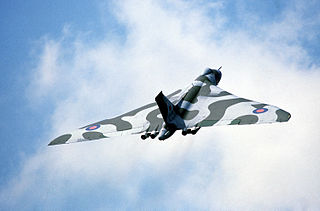
The Avro Vulcan is a jet-powered tailless delta wing high-altitude strategic bomber, which was operated by the Royal Air Force (RAF) from 1956 until 1984. Aircraft manufacturer A.V. Roe and Company (Avro) designed the Vulcan in response to Specification B.35/46. Of the three V bombers produced, the Vulcan was considered the most technically advanced and hence the riskiest option. Several reduced-scale aircraft, designated Avro 707, were produced to test and refine the delta wing design principles.

Avro was a British aircraft manufacturer. Its designs include the Avro 504, used as a trainer in the First World War, the Avro Lancaster, one of the pre-eminent bombers of the Second World War, and the delta wing Avro Vulcan, a stalwart of the Cold War.

The Avro Canada CF-105 Arrow, often known simply as the Avro Arrow, was a delta-winged interceptor aircraft designed and built by Avro Canada. The CF-105 held the promise of Mach 2 speeds at altitudes exceeding 50,000 feet (15,000 m) and was intended to serve as the Royal Canadian Air Force's (RCAF) primary interceptor into the 1960s and beyond.

Avro Canada was a Canadian aircraft manufacturing company. It started in 1945 as an aircraft plant and within thirteen years became the third-largest company in Canada, one of the largest 100 companies in the world, and directly employing over 50,000. Avro Canada was best known for the CF-105 Arrow, but through growth and acquisition, it rapidly became a major, integrated company that had diverse holdings.

A strategic bomber is a medium- to long-range penetration bomber aircraft designed to drop large amounts of air-to-ground weaponry onto a distant target for the purposes of debilitating the enemy's capacity to wage war. Unlike tactical bombers, penetrators, fighter-bombers, and attack aircraft, which are used in air interdiction operations to attack enemy combatants and military equipment, strategic bombers are designed to fly into enemy territory to destroy strategic targets. In addition to strategic bombing, strategic bombers can be used for tactical missions. There are currently only three countries that operate strategic bombers: the United States, Russia and China.

Hawker Siddeley was a group of British manufacturing companies engaged in aircraft production. Hawker Siddeley combined the legacies of several British aircraft manufacturers, emerging through a series of mergers and acquisitions as one of only two such major British companies in the 1960s. In 1977, Hawker Siddeley became a founding component of the nationalised British Aerospace (BAe). Hawker Siddeley also operated in other industrial markets, such as locomotive building and diesel engine manufacture. The company was once a constituent of the FTSE 100 Index.
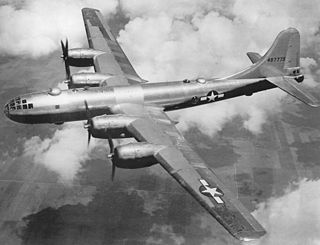
Heavy bombers are bomber aircraft capable of delivering the largest payload of air-to-ground weaponry and longest range of their era. Archetypal heavy bombers have therefore usually been among the largest and most powerful military aircraft at any point in time. In the second half of the 20th century, heavy bombers were largely superseded by strategic bombers, which were often smaller in size, but had much longer ranges and were capable of delivering nuclear weapons.

A mother ship, mothership or mother-ship is a large vehicle that leads, serves, or carries other smaller vehicles. A mother ship may be a maritime ship, aircraft, or spacecraft.
A circular wing is a disc-shaped wing having the outer planform of a circle.

Aviation Week & Space Technology, often abbreviated Aviation Week or AW&ST, is the flagship magazine of the Aviation Week Network. The weekly magazine is available in print and online, reporting on the aerospace, defense and aviation industries, with a core focus on aerospace technology. It has a reputation for its contacts inside the United States military and industry organizations.
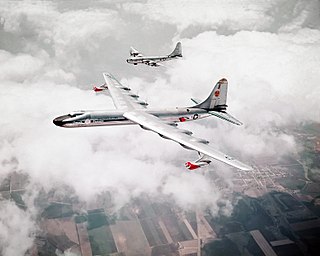
A nuclear-powered aircraft is a concept for an aircraft intended to be powered by nuclear energy. The intention was to produce a jet engine that would heat compressed air with heat from fission, instead of heat from burning fuel. During the Cold War, the United States and Soviet Union researched nuclear-powered bomber aircraft, the greater endurance of which could enhance nuclear deterrence, but neither country created any such operational aircraft.
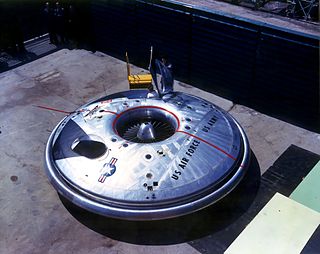
The Avro Canada VZ-9 Avrocar was a VTOL aircraft developed by Avro Canada as part of a secret U.S. military project carried out in the early years of the Cold War. The Avrocar intended to exploit the Coandă effect to provide lift and thrust from a single "turborotor" blowing exhaust out the rim of the disk-shaped aircraft. In the air, it would have resembled a flying saucer.
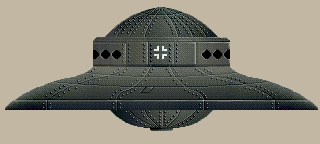
In ufology, conspiracy theory, science fiction, and comic book stories, claims or stories have circulated linking UFOs to Nazi Germany. The German UFO theories describe supposedly successful attempts to develop advanced aircraft or spacecraft prior to and during World War II, and further assert the post-war survival of these craft in secret underground bases in Antarctica, South America, or the United States, along with their creators. According to these theories and fictional stories, various potential code-names or sub-classifications of Nazi UFO craft such as Rundflugzeug, Feuerball, Diskus, Haunebu, Hauneburg-Gerät, V7, Vril, Kugelblitz, Andromeda-Gerät, Flugkreisel, Kugelwaffe, and Reichsflugscheibe have all been referenced.
The Royal Aviation Museum of Western Canada is a museum in Winnipeg, Manitoba, Canada. The museum is temporarily closed for relocation, and is scheduled to reopen in 2021.

John Carver Meadows Frost known as "Jack" was a British aircraft designer. His primary contributions centred on pioneering supersonic British experimental aircraft and as the chief designer who shepherded Canada's first jet fighter project, the Avro Canada CF-100, to completion. He was also the major force behind the Avro Canada VTOL aircraft projects, particularly as the unheralded creator of the Avro Canada flying saucer projects.
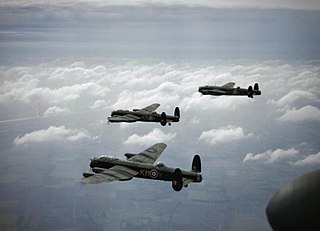
No. 44 (Rhodesia) Squadron was an aviation unit of the Royal Air Force. It was active between 1917 and 1982. For most of its history it served as a heavy bomber squadron.

A flying saucer is a descriptive term for a supposed type of flying craft having a disc or saucer-shaped body, commonly used generically to refer to an anomalous flying object. The term was coined in 1947 but has generally been supplanted since 1952 by the United States Air Force term unidentified flying objects. Early reported sightings of unknown "flying saucers" usually described them as silver or metallic, sometimes reported as covered with navigation lights or surrounded with a glowing light, hovering or moving rapidly, either alone or in tight formations with other similar craft, and exhibiting high maneuverability.
The Bomber Gap was the Cold War belief that the Soviet Union's Long Range Aviation department had gained an advantage in deploying jet-powered strategic bombers. Widely accepted for several years, the gap was used as a political talking point in the United States to justify a great increase in defense spending.
References
- ↑ Heppenheimer, T. A. (1998). The Space Shuttle Decision. NASA. p. 193.
- ↑ "Soviets Flight Testing Nuclear Bomber", Aviation Week, 1 December 1958, p. 27.
- ↑ Soviet Nuclear Plane Possibility Conceded, Ford Eastman, Aviation Week, 19 January 1959, p. 29.
- ↑ Guy Norris, "False Starts For Aviation’s ‘Atomic Age’", Aviation Week, 14 October 2014
- ↑ Is this the real Flying Saucer?, Look, Volume 19, 14 June 1955
- ↑ Governor to push global warming fight - Bold policy gambits expected in bid to lower greenhouse gases, San Francisco Chronicle, 17 February 2006
- ↑ Why the U.S. Should Withdraw from the Montreal Protocol Archived 2010-07-18 at the Wayback Machine , The National Center for Public Policy Research, February 1997
- ↑ "MSN | Outlook, Office, Skype, Bing, Breaking News, and Latest Videos". www.msn.com. Archived from the original on 2019-01-31. Retrieved 2019-08-22.
- ↑ "CNN.com - Transcripts". transcripts.cnn.com. Retrieved 2019-08-22.
- ↑ "The perils of public health by press release," Lancet, 2004 Sep 18;364:1037-1038